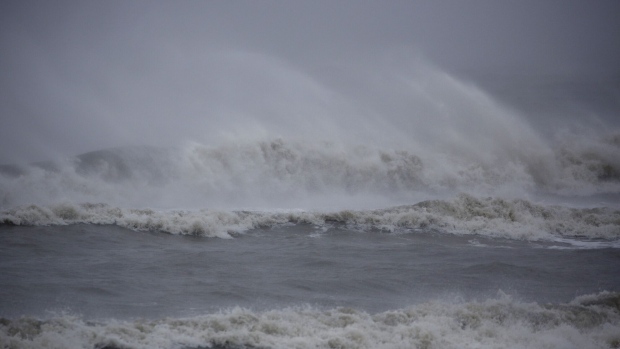Category 5 Hurricane Hilary Poses Imminent Threat to Southern California

Category 5 Hurricane Hilary Poses Imminent Threat to Southern California
In a startling turn of events, Southern California finds itself bracing for the arrival of a formidable Category 5 hurricane, aptly named Hurricane Hilary. Weather experts and meteorologists have issued dire warnings as the massive storm gathers momentum over the warm waters of the Pacific Ocean. With wind speeds exceeding 157 miles per hour, this potent weather system threatens to unleash its fury upon the picturesque coastal region, leaving residents and authorities alike on high alert.
As Hurricane Hilary steadily approaches, the region is urged to prepare for the worst. Local officials have initiated emergency response measures, calling for mandatory evacuations in the most vulnerable areas along the coastline. Schools and businesses have shuttered their doors, while residents rush to secure their homes and gather essential supplies to weather the impending tempest.
Meteorological data paints a grim picture as Hurricane Hilary churns westward. Its immense size and intensity have been attributed to unusually warm ocean temperatures, a phenomenon that scientists warn could become more common due to climate change. The hurricane’s rapid intensification serves as a stark reminder of the need for concerted global efforts to address the environmental challenges that contribute to such catastrophic weather events.

Governor Janet Mitchell has addressed the state, urging citizens to heed evacuation orders and remain vigilant. “We cannot underestimate the destructive potential of Hurricane Hilary,” she warned in a press conference. “Our top priority is to ensure the safety of our residents, and we will spare no effort in our preparedness and response efforts.”
Emergency shelters have been set up across the region to accommodate those displaced by the storm. Authorities are working tirelessly to provide support to vulnerable populations, including the elderly, disabled, and economically disadvantaged. The Red Cross and other humanitarian organizations have mobilized volunteers and resources to assist in relief efforts, emphasizing the importance of unity in times of crisis.
Transportation networks have been severely impacted as Hurricane Hilary’s outer bands begin to lash the coastal areas. Flights in and out of major airports have been canceled, and roadways have become treacherous due to flooding and debris. Law enforcement and emergency crews are navigating these challenges to ensure the safe evacuation of residents and to maintain order in the face of mounting chaos.

Meteorologists are closely monitoring the storm’s trajectory, predicting that Hurricane Hilary will make landfall within the next 24 to 48 hours. Coastal cities such as Los Angeles, San Diego, and Santa Barbara are expected to bear the brunt of the hurricane’s force. Residents are advised to stay informed through reliable sources and to follow evacuation orders without delay.
In addition to its ferocious winds, Hurricane Hilary brings with it the potential for catastrophic storm surges. Coastal areas are at risk of experiencing inundation from the sea, posing a significant threat to both property and lives. The combination of powerful winds, heavy rainfall, and flooding has the potential to wreak havoc on the region’s infrastructure, disrupting power and water supplies for an extended period.
As the world watches the unfolding crisis in Southern California, experts and officials are emphasizing the importance of disaster preparedness and climate resilience. The severity of Hurricane Hilary serves as a sobering reminder that extreme weather events are no longer distant possibilities, but rather urgent realities that demand our immediate attention.
With the clock ticking down to Hurricane Hilary’s anticipated landfall, emergency response teams are working tirelessly to coordinate relief efforts and provide assistance to those in need. Medical facilities have been reinforced, and supplies of essential medications have been stockpiled to ensure the well-being of those who may require medical attention during and after the storm. However, the challenges posed by the hurricane extend beyond immediate safety concerns; the disruption of supply chains and potential damage to agriculture raise concerns about food security and access to basic necessities in the aftermath.

The impact of Hurricane Hilary is reverberating beyond the borders of Southern California. Neighboring states and even international partners are offering support and resources to aid in the response and recovery efforts. This spirit of solidarity highlights the importance of global cooperation in addressing the increasing frequency and intensity of extreme weather events. As rescue teams stand ready to deploy, and volunteers come together to provide assistance, the collective response to Hurricane Hilary exemplifies the resilience and strength of communities in the face of adversity.
Climate scientists are sounding the alarm, emphasizing that Hurricane Hilary is not an isolated incident but rather a glimpse into a future that could be marked by more frequent and severe weather events. The hurricane’s formation and rapid intensification are consistent with the patterns predicted by climate models, underlining the urgent need for proactive measures to mitigate the impacts of climate change. As governments, industries, and individuals grapple with the long-term implications of a changing climate, Hurricane Hilary serves as a call to action to accelerate efforts to reduce greenhouse gas emissions and transition to sustainable energy sources.
In the midst of uncertainty and challenge, stories of resilience and heroism are emerging. Local residents are opening their homes to those in need, community organizations are mobilizing to provide aid, and first responders are working tirelessly to keep people safe. As the winds howl and the rain pours, the people of Southern California are demonstrating their ability to come together, support one another, and face the storm with unwavering determination. The lessons learned from Hurricane Hilary will undoubtedly shape the region’s preparedness for future disasters and reinforce the importance of safeguarding our planet for generations to come.
In conclusion, Hurricane Hilary’s relentless approach toward Southern California has thrust the region into a state of emergency. The impending landfall of this Category 5 storm has prompted widespread evacuations, disrupted transportation, and raised concerns about the potential for devastating damage. As communities unite to weather the storm and support one another, the impact of Hurricane Hilary underscores the need for proactive climate action and disaster preparedness on both local and global scales.



